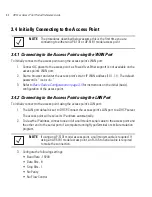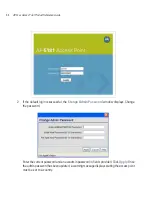
Getting Started
3-11
c. If using the static or DHCP Server option, enter the network-assigned
IP Address
of the
access point.
d. The
Subnet Mask
defines the size of the subnet. The first two sets of numbers specify
the network domain, the next set specifies the subset of hosts within a larger network.
These values help divide a network into subnetworks and simplify routing and data
transmission.
e. If using the static or DHCP Server option, enter a
Default Gateway
to
define the
numerical IP address of a router the access point uses on the Ethernet as its default
gateway.
f. If using the static or DHCP Server option, enter the
Primary DNS Server
numerical IP
address.
g. If using the DHCP Server option, use the
Address Assignment Range
parameter to
specify a range of IP address reserved for mapping clients to IP addresses. If a manually
(static) mapped IP address is within the IP address range specified, that IP address could
still be assigned to another client. To avoid this, ensure all statically mapped IP
addresses are outside of the IP address range assigned to the DHCP server.
For additional access point LAN port configuration options, see
Configuring the LAN
Interface on page 5-1
.
8.
Enable the radio(s) using the
Enable
checkbox(es) within the Radio Configuration field. If
using a single radio access point, enable the radio, then select either 2.4 GHz or 5.2 GHz from
the
RF Band of Operation
field. Only one RF band option at a time is permissible in a
single-radio model. If using a dual-radio model, the user can enable both RF bands. For
additional radio configuration options, see
Configuring the 802.11a or 802.11b/g Radio on
page 5-55
.
9.
Select the
WLAN #1
tab (WLANs 1 - 4 are available within the Quick Setup screen) to define
its ESSID and security scheme for basic operation.
NOTE
DNS names are not supported as a valid IP address for the access point.
The user is required to enter a numerical IP address.
NOTE
A maximum of 16 WLANs are configurable within the Wireless
Configuration screen. The limitation of 16 WLANs exists regardless of
whether the access point is a single or dual-radio model.
Summary of Contents for AP 5131 - Wireless Access Point
Page 1: ...AP 51xx Access Point Product Reference Guide ...
Page 3: ...AP 51xx Access Point Product Reference Guide 72E 103901 01 January 2008 ...
Page 4: ......
Page 44: ...AP 51xx Access Point Product Reference Guide 1 28 ...
Page 76: ...AP 51xx Access Point Product Reference Guide 2 32 ...
Page 92: ...AP 51xx Access Point Product Reference Guide 3 16 ...
Page 588: ...AP 51xx Access Point Product Reference Guide 8 254 ...
Page 610: ...AP 51xx Access Point Product Reference Guide 9 22 3 Define a mesh supported WLAN ...
Page 623: ...Configuring Mesh Networking 9 35 3 Determine the Radio MAC Address and BSSID MAC Addresses ...
Page 653: ...Adaptive AP 10 25 line con 0 line vty 0 24 end ...
Page 654: ...AP 51xx Access Point Product Reference Guide 10 26 ...
Page 666: ...AP 51xx Access Point Product Reference Guide A 12 ...
Page 690: ...AP 51xx Access Point Product Reference Guide C 4 ...
Page 696: ...AP 51xx Access Point Product Reference Guide IN 10 ...
Page 697: ......
















































